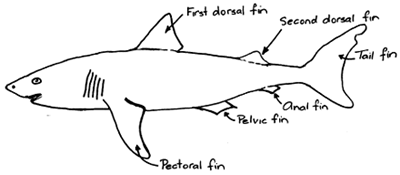Sharks' fins
This task is about using a diagram and information on sharks' fins to answer questions.

Fact File:
- Sharks are shaped a bit like aeroplanes, but move through water instead of air.
- Sharks use their body and tail in a side to side motion to move through the water.
- They have five different kinds of fins. Their fins control their movements.
- Some fins are used for balance.
- Some fins are used for steering.
- Some fins are used for moving upwards or downwards.
- Some fins are used for moving the shark forwards.
Study the diagram of the shark and read the fact file to help you answer the following questions.

